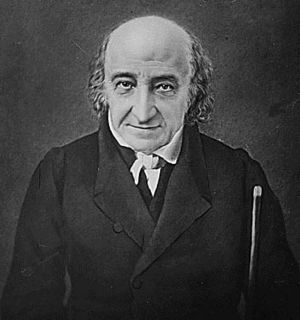Treaty of 1818 facts for kids
| Convention respecting fisheries, boundary, and the restoration of slaves | |
|---|---|

United States territorial border changes
|
|
| Type | Bilateral treaty |
| Context | Territorial cession |
| Signed | October 20, 1818 |
| Location | London, United Kingdom |
| Effective | January 30, 1819 |
| Signatories | |
| Depositary | Government of the United Kingdom |
| Languages | English |
The Treaty of 1818 is an important international agreement. It was signed in 1818 between the United States and the United Kingdom. This treaty helped solve long-standing border problems between the two countries.
It also allowed both nations to share and settle the Oregon Country. This area was known to the British as the Columbia District. It was part of the Hudson's Bay Company lands. The treaty helped set the stage for better relations between the US and Canada.
Contents
What Was the Treaty of 1818?
The official name of this agreement was the "Convention respecting fisheries, boundary, and the restoration of slaves". It is also called the London Convention or the Anglo-American Convention of 1818.
This treaty was a big step. It marked the last time the United Kingdom lost a large piece of land in what is now the Continental United States. It was also the first time the United States gave up a significant part of its North American territory to another country.
Setting the Borders
One key part of the treaty was setting the border. The two nations agreed on a line along the 49th parallel north. This was easier to survey than older borders based on rivers.
- Britain gave up all land south of the 49th parallel. This included parts of the Red River Colony. These areas are now in Minnesota, North Dakota, and South Dakota.
- The United States gave up land north of the 49th parallel. This was the northernmost part of the Missouri Territory.
This agreement fixed a border mistake from the Treaty of Paris (1783). That treaty ended the American Revolutionary War. It had tried to draw a line to the Mississippi River. But the river didn't go that far north. The 1818 treaty solved this problem. It also created the Northwest Angle. This is a small part of Minnesota that is north of the 49th parallel.
Fishing Rights
The treaty also gave the United States important fishing rights. It secured these rights along the coasts of Newfoundland and Labrador. This was very important for American fishermen.
Sharing the Oregon Country
Another major part of the treaty was about the Oregon Country. Both countries agreed to share control of this land for ten years. This meant both the US and Britain could claim land there. They also had free navigation throughout the area.
Other Agreements
- The treaty confirmed an earlier agreement from 1815. This agreement regulated trade between the two countries. It was extended for another ten years.
- The treaty also dealt with claims from the War of 1812. It said that any disagreements over these claims would be sent to a "Friendly Sovereign or State" to be decided. This included disputes over people and property that had moved during the war.
How the Treaty Came to Be
The treaty was signed on October 20, 1818. It became official on January 30, 1819.

Important people helped make this treaty happen:
- For the US: Albert Gallatin and Richard Rush.
- For the UK: Frederick John Robinson and Henry Goulburn.
This treaty, along with the Rush–Bagot Treaty of 1817, helped improve relations. It was a step towards a more positive relationship between the US and Canada.
The Oregon Country Struggle
Even with the agreement, there was a big struggle for the Oregon Country. This lasted for about 20 years. The British Hudson's Bay Company had many trading posts there. They tried to stop US fur traders from coming into the area.
By the 1830s, more and more Americans wanted to claim the region. The Hudson's Bay Company even tried to get rid of all fur-bearing animals. This was to make money and slow down American settlers.
However, John McLoughlin, a leader at Fort Vancouver, helped many US immigrants. He gave them relief and welcomed them after their long journey on the Oregon Trail.
By the mid-1840s, many US settlers were moving to Oregon. There was also a strong political movement to claim the whole territory. This led to a new agreement. The Oregon Treaty in 1846 finally set the border. It made the 49th parallel north the permanent boundary between the US and British North America all the way to the Pacific Ocean.
See also
 In Spanish: Tratado de Londres (1818) para niños
In Spanish: Tratado de Londres (1818) para niños

